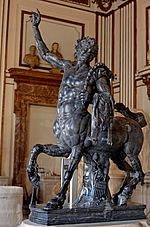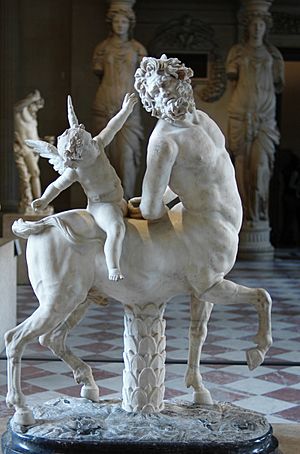Furietti Centaurs facts for kids
The Furietti Centaurs are two famous ancient statues. They show creatures called centaurs, which are mythical beings that are half-human and half-horse. These statues are made of dark grey marble. One centaur looks older and has a sad or pained face. The other centaur is young and smiling, with one arm raised.
Originally, small winged figures called amorini (like little Cupids) were riding on the backs of these centaurs. These small figures are now missing from the statues. The centaurs' different expressions were meant to show how people's feelings can change, from sadness to joy. This idea was important in ancient Greek and Roman thinking.
Discovering the Capitoline Centaurs
These two centaur statues were found together in December 1736. They were discovered at a famous ancient Roman estate called Hadrian's Villa in Tivoli, near Rome. A man named Monsignor Giuseppe Alessandro Furietti found them. They became the most important pieces in his collection of ancient art.
Furietti was offered a high position in the Catholic Church, a cardinal's hat, if he would give the statues to Pope Benedict XIV. But Furietti refused to give them up! He eventually became a cardinal anyway in 1759. After Cardinal Furietti passed away, his family sold the centaurs. They also sold another famous artwork, a mosaic of four drinking doves. The statues were sold for a lot of money and have been kept in the Capitoline Museum in Rome ever since.
Who Made the Centaurs?
Both centaur statues have names carved on them: Aristeas and Papias. These artists were from a city called Aphrodisias in Asia Minor (which is modern-day Turkey). We don't know for sure if they created the original idea for these statues or if they were the ones who carved these specific copies.
It's also not clear where the statues were made. They might have been made in Aphrodisias, or the artists might have traveled from there to Rome to create them. Experts believe these statues are copies made during the time of the Roman Emperor Hadrian, around the late 1st or early 2nd century AD. Many people think they are copies of older Greek bronze statues from the 2nd century BC. However, some experts now believe that many statues thought to be ancient Greek might actually be Roman creations or copies that changed the original ideas.
The Louvre Centaur
There is another copy of the Old Centaur statue. This one is made of white marble. It was found in Rome in the 1600s. It probably had a Young Centaur partner, but that one is now lost. This white marble centaur became part of the Borghese art collection. Later, in 1807, Napoleon bought it, and now it is displayed in the Louvre Museum in Paris, France.
This version of the Old Centaur has a small statue of Eros (the Greek god of love, similar to Cupid) on its back. Eros is shown teasing the centaur. This part is missing from the Capitoline Centaurs. However, some parts of the Louvre statue, like Eros's arm and foot, and the centaur's left arm, have been repaired or added later. The base and the support under the centaur are also modern additions. The centaur's original right arm is pulled back tightly, showing that his hands are tied behind his back. He looks like he is in pain and sorrow as Eros pulls his head back sharply.




